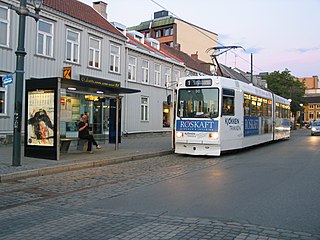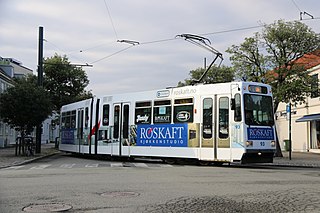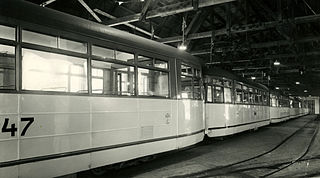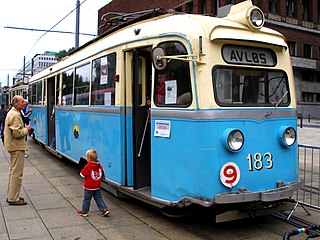
The Gråkallen Line is an 8.8-kilometre (5.5 mi) suburban tram line located in Trondheim, Norway. As the only remaining part of the Trondheim Tramway, it runs from the city centre at St. Olav's Gate, via the suburban area Byåsen to Lian. It is designated Line 9, and is served by six Class 8 articulated trams. After the closure of the Arkhangelsk tramway in 2004, it became the world's northernmost tramway system.
Trondheim Trafikkselskap or TT was the city public transport company for Trondheim, Norway between 1974 and 2001. It operated both the city buses, and the Trondheim Tramway until 1988. The company was owned by the city council.

The Trondheim Tramway in Trondheim, Norway, is the world's most northerly tramway system, following the closure and dismantling of the Arkhangelsk tramways in Russia. It consists of one 8.8-km-long line, the Gråkallen Line, running from St. Olav's Gate in the city centre through Byåsen to Lian Station in Bymarka.

The Singsaker Line was a branch of the Trondheim Tramway which ran from Øya and Elgeseter to the neighborhoods of Singsaker, parts of Tyholt and Rosenborg in Trondheim, Norway. The line branched off from the Elgeseter Line at the Student Society. It was double track until Tyholtveien, after which it ran through a loop through Rosenborg. It was served by Line 3, which continued through the city center to Trondheim Central Station.

AS Oslo Sporveier is a defunct municipal owned company responsible for public transport in Oslo, Norway. It was created in 1924 to take over the city's two private tram companies. In 1927 its started with bus transport, including from 1940 to 1968 trolleybuses. Since 1966 rapid transit and from 1985 water buses have also been operated by the company. It was split into two separate companies in 2006; Kollektivtransportproduksjon took over the operation while Oslo Public Transport Administration was responsible for buying the services, fare regulation and marketing. The latter merged into Ruter in 2008, when the Oslo Sporveier brand was discontinued.
A/S Graakalbanen was a private company that built and operated the Gråkallen Line of the Trondheim Tramway between 1924 and 1972. Established in 1916, it bought large land areas in Byåsen, and built a tramway through these to reach the recreational areas in Bymarka. The line first reached Munkvoll in 1924, Ugla in 1925, and finally Lian in 1933. The company owned through its history seven trams and five trailers, and only in the last few years did it operate six borrowed TS Class 7 trams.

The Lade Line was a tramway between Munkegata and Lade in Trondheim, Norway. The first part of the line was opened in 1901, but not expanded to Lade until 1958. The line was operated by Trondheim Sporvei and Trondheim Trafikkselskap until it was abandoned in 1988.

AS Sporveisbussene is a bus company that operates about 75% of the routes in Oslo, Norway. The company was created in 1997 when the then Oslo Sporveier was reorganised. It is now a subsidiary of Kollektivtransportproduksjon, a municipal company responsible for operating public transport in Oslo. In 2003 the Oslo City Council decided that bus transport in Oslo was to be based on public service obligation contracts, and Sporveisbussene has steadily lost its routes to these contracts. Instead, Sporveisbussene has established a subsidiary, Nexus Trafikk, that can compete in the competitions, and has won many of them. The company also operates the express coaches branded Lavprisekspressen.
The Hospitalløkkan Depot was the first depot for the Trondheim Tramway. Built in 1901 by Trondhjems Elektricitetsværk og Sporvei, it had a capacity of 16 trams. The administration of the company was also located at Hospitalløkkan. The station was located close to the end of the Ila Line. In 1923 it was taken out of use.

The Trondheim Tramway controversy regards the political discussion of whether Trondheim, Norway, should have a tramway.

TT Class 8 are the only remaining trams used on the Trondheim Tramway. Built by Linke-Hofmann-Busch (LHB) in 1984–85, they replaced the aging Class 7 trams used by Trondheim Trafikkselskap (TT). Of the eleven built, nine remain in service on the Gråkallen Line operated by Boreal Bane.

TS Class 2 was a series of twelve trams built by Skabo Jernbanevognfabrikk for Trondheim Sporvei. They were delivered between 13 September 1913 and November 1917, and used on the newly opened Elgeseter Line.

TS Class 3 was a series of ten trams built by Hannoversche Waggonfabrik (HaWa) for Trondheim Sporvei. They were delivered in November 1922, and put into service on 4 and 22 December. They remained in service until 1962.

TS Class 4 was a series of five trams built by Strømmens Værksted for Trondheim Sporvei. They were delivered in 1930, and numbered 35–39.

TS Class 5 was a series of six trams built by Skabo Jernbanevognfabrikk for Trondheim Sporvei. Four were delivered from December 1937 to February 1938, while two were delivered in May 1942.

TS Class 6 was a series of sixteen trams built by Strømmens Værksted for Trondheim Sporvei. They were delivered in two slightly different batches; ten in 1948–49 and six in 1955.

TS Class 7 was a series of 28 trams and 15 trailers built by Strømmens Værksted for Trondheim Sporvei. They were delivered in 1956–57.

Class B and Class E, normally referred to as Gullfisk, were a class of 46 trams built by Strømmens Værksted and Skabo Jernbanevognfabrikk for Oslo Sporveier and Bærumsbanen of Oslo, Norway, in 1937 and 1939. They were the first aluminium trams to operate on the Oslo Tramway and the first bogie trams to operate on street lines. They had contemporary modern electronic equipment, a streamlined shape, and comfortable accommodation. Until 1964, they were also faster than any other Norwegian tramcar or suburban railcar.

SM53, originally designed MBO and colloquially known as Høka, were a class of 58 trams and 50 trailers built by Høka and Hägglund for Oslo Sporveier. The units were used on the Norway's Oslo Tramway from 1952 until 2000. The 14.7-meter long and 2.5-meter wide trams weighed 16.9 tonnes. They had four motors providing a combined power output of 180 kilowatts (240 hp), allowing for a top speed of 60 kilometers per hour (37 mph).
Hønefoss Jernbanevogn- og Karosserifabrikk A/S, trading as Høka and at first known as Hønefoss Karosserifabrikk A/S, was a manufacturer of bodywork for buses, trucks and trains. The company was in existence from 1936 to 1968 and was based in Hønefoss, Norway. Among the company's products is Oslo Tramway's SM53 trams, the Trondheim Tramway's GB Class 3 tram and the Norwegian State Railways Skd 221 shunters.















